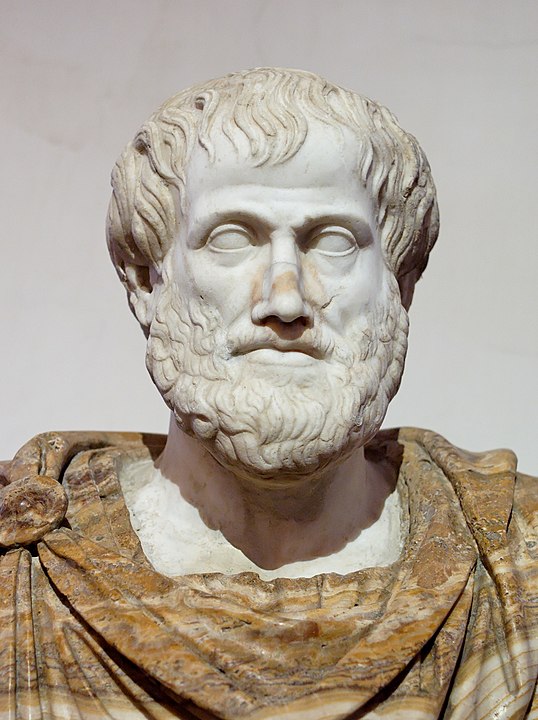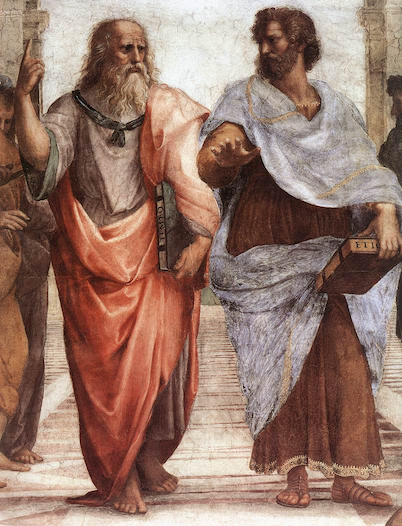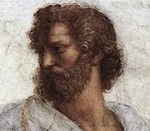Introduction

A bust of Aristotle.
Aristotle (384 BC – 322 BC) was a Greek philosopher who is widely regarded as one of the most important thinkers in human history. He conducted research into every available topic of scholarly interest, including logic, biology, ethics, physics, metaphysics, epistemology, political theory, aesthetics, and rhetoric. In each of these fields of study, Aristotle put forward revolutionary new ideas, organized a clarifying synthesis of previous views, and did so in a vast body of written work of which only a small fraction survives today. Aristotle’s enormous influence on the history of philosophy is matched only by his teacher, Plato, and even thousands of years after his life, Aristotle’s works are still widely studied.
Aristotle’s Life and Work
“It appears to me that there can be no question, that Aristotle stands forth, not only as the greatest figure in antiquity, but as the greatest intellect that has ever appeared upon the face of this earth.” ―George J. Romanes, evolutionary biologist and friend of Charles Darwin (1910)
Historical information on Aristotle’s life is generally uncertain, unclear, and unreliable. The commonly-told story is that he was the son of the Macedonian king’s physician and that he moved to Athens at the age of seventeen to study at Plato’s Academy. He stayed there for twenty years, learning Plato’s philosophy and rigorously studying the works of earlier thinkers. When Plato died in 347 BC, Aristotle left Athens for Assos, a town in what is now Turkey. On the nearby island Lesbos, Aristotle founded his own academy where he led a group of scholars in researching philosophy and biology.
After marrying a woman named Pythias, Aristotle moved back to Macedonia at the request of their king, Philip, in order to tutor the monarch’s son, Alexander. But this was no ordinary student: the young boy would grow up to be Alexander the Great, and Aristotle’s close relationship with him would, at different times, prove both useful and dangerous.
Aristotle returned to Athens to create a new school, the Lyceum, where he and his students (called the Peripatetics) researched a colossally extensive array of subjects, including all branches of philosophy, the physical sciences, rhetoric, poetry, politics, psychology, theology, art, mathematics, music, and more. It is often said that Aristotle asked Alexander to collect and send exotic animal specimens as he conquered the known world, and Aristotle’s meticulous biological observations were unprecedented in their scope, in their empirical basis, and in their long-lasting legacy. But his relationship with Alexander was a double-edged sword: After the conqueror’s death in 323, Athens became embroiled in anti-Macedonian sentiment, inciting Aristotle to flee the city. Legend says that Aristotle left in order to disallow Athens from sinning against philosophy twice, referring to their first sin of executing Socrates. But despite his life-saving departure, Aristotle died soon after, probably of natural causes, in 322 BC.
Aristotle produced a massive body of written work in his lifetime, including many dialogues and hundreds of treatises. He was widely praised for both his intellectual feats and his literary style: Cicero, a Roman politician and philosopher, wrote that if Plato’s prose was silver, then Aristotle’s was a flowing river of gold. He was likely referring to Aristotle’s written dialogues, but tragically, none of these literary works survive today. We possess only 31 of Aristotle’s treatises, and these writings, which were something like lecture notes or draft manuscripts, were probably not even meant for public readership. With obscure technical vocabularies, confusing organization, and difficult sentence structures, the texts we have are a far cry from rivers of gold. But despite the demanding and austere style of Aristotle’s remaining works, many of the ideas he explored still resonate deeply today, and the enormity of his intellectual accomplishment is breathtaking.
Aristotle’s philosophy compared to Plato’s philosophy

Plato and Aristotle in Raphael’s School of Athens.
“Human beings now begin and originally began to philosophize because of wonder, at first because they wondered about the strange things right in front of them, and then later, by gradual progression, because they came to find greater things puzzling.” ―Aristotle, Metaphysics, 982b
Aristotle followed his teacher, Plato, in investigating a wide variety of philosophical and scientific topics, and the two great thinkers are often contrasted with each other. The famous Renaissance painting by Raphael, The School of Athens, depicts Plato with his finger pointing at the sky and Aristotle with his palm facing the ground. Raphael’s representation symbolizes the philosophers’ respective philosophies, with Plato aiming toward an abstract rational understanding of the “intelligible world” as conceived through the mind, and Aristotle aiming toward an empirical understanding of the earthly world as perceived through the senses.
The soul as the form of the body
Plato argued that the soul (translated from the Greek word psyche) was an immaterial entity that could exist separately from the body and separately even from the entire material world, whereas Aristotle argued that the ‘soul’ was instead the form, or organization, of the body, and thus cannot exist without the body. Aristotle, in this way, brought Plato’s philosophy “down to earth,” so to speak, explaining the wonders of existence by investigating the physical and sensible world rather than the spiritual and intelligible world.
The empirical study of biology
Aristotle also spent much of his time studying the biology of plants and animals, systematically investigating their features and classifying them into a taxonomy that remained the state of the art for over two thousand years. His meticulous detail in observing and investigating physical organisms demonstrates his focus on empiricism, or, in other words, his reliance on sense perception as a major source of knowledge; Plato, on the other hand, can be considered a rationalist, which means that he thought our most important knowledge comes not from sense perception but rather from innate ideas in the mind. The debate between Plato’s rationalism and Aristotle’s empiricism remained a central problem in philosophy for millennia until Immanuel Kant’s 18th-century work synthesized the two views.
Universals, forms, and hylomorphism

Does the number two exist by itself in an immaterial world of universal, pure, and unchanging Forms, or does it only exist when instantiated in, say, two particular apples?
Aristotle cemented his rejection of Plato’s rationalism when he argued against his teacher’s theory of Forms. Plato was trying to explain how we come to know universal concepts when we only have access to particular things in the physical world. For example, when we say that two apples, two people, and two rocks are particular instances of the number two, or that the sky, the ocean, and blueberries are particular instances of the color blue, we are describing these particular objects in terms of universal concepts that they have in common and in which they each “participate”. The number two and the color blue are examples of universals which we apparently know about, but we never perceive the number two on its own, nor do we see the color blue in itself. Instead, we only ever see their particular instantiations. The question then arises: How do we obtain knowledge of universals if we only see particulars? Plato argued that universal concepts, which he called Forms, exist in an immaterial dimension of reality that we access with our rational souls, and that this intelligible world provides us with knowledge that is pure and not subject to change or imperfections, unlike the ever-changing and imperfect knowledge we have of the sensible, physical world.
But Aristotle rejected this view. He argued instead that universals do not exist on their own, but only when they are instantiated in particular objects. For Aristotle, all objects consist of a combination of matter and form, a view called hylomorphism. Matter is the substance out of which things are made, and form is the organization which structures matter into particular things. Forms, then, do not exist in an immaterial intelligible world, but rather must be found in particular physical objects perceived by the senses.
Systematizing and building on Plato
Despite the important difference between their rationalism and empiricism, Plato’s and Aristotle’s philosophical ideas were often very much alike. In many cases, Aristotle worked to systematize ideas that Plato had thought about in relatively vague ways, and he would try to clarify and improve Plato’s philosophy as he did so. For instance, Plato regularly used logical reasoning in his works, but it was Aristotle who put it together into an explicit, formal, and systematic explanation of logic itself.
Ethics
In their discussions of ethics, too, Plato and Aristotle had similar views. Both are considered to be exponents of virtue ethics, which today is one of the three major approaches to ethics (these three approaches are: virtue ethics, which focuses on moral character; deontology, which focuses on moral duty; and consequentialism, which focuses on the moral consequences of actions). For virtue ethicists such as Plato and Aristotle, one’s ethical standing depends on the kind of person one is and the kind of character one possesses; one becomes a good person by obtaining and acting in accordance with a virtuous moral character, such as one with courage, kindness, wisdom, and discipline. Aristotle argued that virtue lies in the mean (or the average) between two extremes. The virtue of courage, for instance, lies directly in the middle of one extreme, cowardice, and the opposite extreme, recklessness.
Teleological implications for ethics
Aristotle argued that all actions are done for the sake of an end or purpose, and that there must be some final end that is sought solely for its own sake. He called this final end–the end in itself–eudaimonia, which can be translated as ‘happiness’ or ‘flourishing.’ For Aristotle, the central question in ethics is how humans can attain eudaimonia. To figure this out, he appealed to the teleological view that informs much of his philosophical work; or, in other words, to the view that all things have an intrinsic purpose built into them, a particular function which is what the thing is for, and which distinguishes it from other things. The best human life, then, is one that is lived in accordance with our natural function as humans. Aristotle argues that the human function must be reason, since he thought that no other kind of being possesses reason, and so the eudaimonic human life is one lived in accordance with reason. Practically, this means one should use reason to develop a virtuous moral character.
Influence on the medieval world in Europe and the Middle East
Aristotle was hugely influential to Christian and Islamic philosophers and theologians in the medieval era. In the Christian world, his ideas were mediated through the works of St. Thomas Aquinas, who held Aristotle in such high regard that he referred to him as “The Philosopher.” In the Islamic world, Ibn Sina and Ibn Rushd translated Aristotle’s works into Arabic and extended Aristotle’s influence into Islamic philosophy and theology. Like Aquinas, they viewed Aristotle as so important that they gave him an honorific name, “The First Teacher”.
Conclusion
Aristotle was one of the most important thinkers of all time, greatly influencing the course of philosophy and world history. One would do well to use his ethics to live a more fulfilling life, and for anyone interested in understanding the history of philosophical and scientific inquiry, Aristotle is essential reading.

